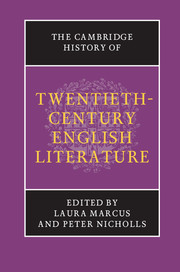Book contents
- Frontmatter
- Introduction
- PART ONE WRITING MODERNITY
- PART TWO THE EMERGING AVANT-GARDE
- PART THREE MODERNISM AND ITS AFTERMATH, 1918–1945
- PART FOUR POST-WAR CULTURES, 1945–1970
- 25 Culture, class and education
- 26 Post-war broadcast drama
- 27 Drama and the new theatre companies
- 28 Modernism and anti-Modernism in British poetry
- 29 Nation, region, place: devolving cultures
- 30 The sixties: realism and experiment
- 31 ‘Voyaging in’: colonialism and migration
- PART FIVE TOWARDS THE MILLENNIUM, 1970–2000
- Bibliography
- Index
- References
25 - Culture, class and education
from PART FOUR - POST-WAR CULTURES, 1945–1970
Published online by Cambridge University Press: 28 March 2008
- Frontmatter
- Introduction
- PART ONE WRITING MODERNITY
- PART TWO THE EMERGING AVANT-GARDE
- PART THREE MODERNISM AND ITS AFTERMATH, 1918–1945
- PART FOUR POST-WAR CULTURES, 1945–1970
- 25 Culture, class and education
- 26 Post-war broadcast drama
- 27 Drama and the new theatre companies
- 28 Modernism and anti-Modernism in British poetry
- 29 Nation, region, place: devolving cultures
- 30 The sixties: realism and experiment
- 31 ‘Voyaging in’: colonialism and migration
- PART FIVE TOWARDS THE MILLENNIUM, 1970–2000
- Bibliography
- Index
- References
Summary
We think of the post-war period as a rising time: rising standards of living, rising rates of literacy (fuelled by the guarantee of secondary state education until fifteen) and ‘The Rise of the Provincials’ – as it was called by Malcolm Bradbury – into the ranks of the cultural and intellectual elite. Most of all, the post-war period appears to us as the moment when capitalism finally hits its stride. It had promised, since its inception, steady progress towards a more prosperous, more secure, and – from the mid-nineteenth century onwards – fairer society. But the progress and the assurances were always upset by periodic catastrophes it seemed unable to escape: the great depressions of the 1870s and the 1930s, the brutal inter-capitalist wars that sprung up regularly from 1800 to the middle of the twentieth century, the revolutions and murderous counter-revolutions that punctured the self-image of civilised Europe.
From 1945 onwards, things were different. Keynesian economic policies used state expenditure to avoid dramatic economic crises; the welfare state’s panoply of new benefits and public institutions, by stealing socialism’s thunder, kept the lid on class conflict; and the twin facts of the Common Market and the domination of Europe by the Cold War ensured there would be no further inter-capitalist armed conflict. As a result of these arrangements, British social life acquired a distinctive rhythm and feel, which structured the sense of what social life was fundamentally like for three generations.
- Type
- Chapter
- Information
- The Cambridge History of Twentieth-Century English Literature , pp. 453 - 473Publisher: Cambridge University PressPrint publication year: 2005

